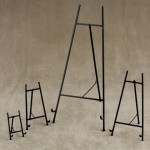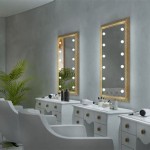Hanging Vanity Mirror Height: A Comprehensive Guide
The optimal height for hanging a vanity mirror is a crucial consideration for both aesthetics and functionality in any bathroom or dressing area. Proper mirror placement can significantly enhance usability and contribute to the overall design of the space. Determining the correct height involves factoring in the height of the vanity, the height of the users, and the desired visual effect. Deviation from established guidelines can result in discomfort during use and an unbalanced appearance.
This article provides a detailed examination of the factors influencing the appropriate height for hanging a vanity mirror, offering practical guidance for achieving effective and aesthetically pleasing mirror placement. It explores the common standards, considerations for varied user heights, different styles of mirrors, and the importance of lighting in relation to mirror positioning.
Understanding Standard Mounting Heights
The most frequently recommended height for hanging a vanity mirror centers around the principle of ensuring comfortable visibility for the average adult. Industry standards generally suggest positioning the center of the mirror at approximately 60 to 65 inches from the floor. This range allows individuals of average stature to view themselves comfortably without straining their necks or bending down. However, it is essential to recognize that these are merely guidelines and may need adjustment based on specific circumstances.
The height of the vanity itself plays a pivotal role in determining the optimal mirror placement. Standard vanity heights typically range from 30 to 36 inches. When the vanity is installed, the distance between the top of the vanity and the bottom of the mirror should generally be between 5 and 10 inches. This spacing prevents the mirror from appearing too close to the countertop, which can lead to water splashing and potential damage. Conversely, too much space can create an awkward visual gap.
Applying these principles, if a vanity stands at 32 inches, positioning the bottom edge of the mirror approximately 37 to 42 inches from the floor creates a balanced and functional arrangement. By following these guidelines, the mirror serves its functional purpose while also integrating harmoniously with the overall bathroom design. Careful measurement and planning are necessary to achieve the desired effect.
Accounting for User Height Variation
While standard recommendations provide a general starting point, the most effective approach to determining vanity mirror height involves customizing placement based on the heights of the primary users. This is particularly important in households with individuals of significantly varying heights. Ignoring this factor can lead to one or more users experiencing discomfort or an obstructed view.
To tailor mirror height to individual needs, measure the height of the shortest and tallest individuals who will regularly use the vanity. The goal is to position the mirror so that both users can comfortably see their faces without excessive bending or stretching. A practical method involves calculating the midpoint between the eye levels of the tallest and shortest users. This midpoint should ideally align with the center of the mirror. In cases where a single mirror serves multiple users with substantial height differences, compromise may be necessary. In some situations, individual adjustable mirrors may be a more suitable solution.
For children, consider adding a step stool if a full-sized vanity mirror is used. Alternatively, a smaller, supplementary mirror mounted at a lower height can be installed specifically for their use. This allows children to develop independence in their grooming routines without compromising the functionality of the main mirror.
In situations where universal accessibility is required, such as in public restrooms or homes accommodating individuals with mobility limitations, consider adhering to ADA (Americans with Disabilities Act) guidelines. These guidelines specify mirror heights and angles that accommodate wheelchair users and individuals with varying physical abilities. In these cases, adjustable mirrors or tilted mirrors may be the most suitable solution to ensure equitable access.
Mirror Style and Mounting Considerations
The style of the vanity mirror significantly impacts the optimal mounting height. Different mirror designs necessitate unique installation considerations to ensure both functionality and aesthetic appeal. Framed mirrors, frameless mirrors, and medicine cabinets all require specific approaches to achieve the desired effect.
Framed mirrors, distinguished by their decorative surrounds, should be hung so that the frame itself aligns symmetrically with the vanity. When measuring for frame mirrors, always include the frame in the measurement. The bottom of the frame should be positioned at the appropriate distance above the vanity, typically between 5 and 10 inches, while ensuring the center of the mirrored area remains within the 60- to 65-inch height range. The frame contributes to the overall visual impact, so its positioning relative to the vanity and surrounding elements is crucial.
Frameless mirrors, characterized by their minimalist design, offer a more streamlined and contemporary look. When mounting frameless mirrors, it's essential to focus on the reflective surface. Since there is no frame to consider, position the bottom edge of the glass at the desired height above the vanity, keeping in mind the average height of the users and the overall aesthetic of the bathroom. Frameless mirrors often create an illusion of spaciousness, so their placement can significantly influence the perceived size of the room.
Medicine cabinets, which combine a mirror with storage space, require careful planning during installation. The height of the medicine cabinet should be determined by considering the accessibility of the shelves and the visibility of the mirror. Generally, the top shelf of the medicine cabinet should be within easy reach for the primary users, preventing the need for excessive stretching or bending. Ensure the mirrored portion of the cabinet is positioned at a height that allows comfortable viewing. Medicine cabinets often require more substantial mounting hardware due to their weight, so structural support within the wall is a critical consideration.
Furthermore, the mounting method itself plays a role in determining the final placement. Mirrors can be hung using various techniques, including wire hangers, brackets, or adhesive. The choice of mounting method can affect the ease of adjustment and the stability of the mirror. Ensure the chosen method is appropriate for the weight and size of the mirror and that it complies with local building codes.
The Interplay of Lighting and Mirror Height
Lighting and mirror placement are intrinsically linked, and the effectiveness of one directly impacts the other. Proper lighting enhances the functionality of the mirror, while incorrect lighting can create unflattering shadows or glare, compromising its usability. Therefore, careful consideration of lighting options is crucial when determining the optimal height for a vanity mirror.
Sconces, mounted on either side of the mirror, are a popular choice for vanity lighting. This arrangement provides balanced illumination, minimizing shadows and creating a more even light distribution. When using sconces, position them at approximately eye level, typically around 60 to 66 inches from the floor. Ensure the width between the sconces is sufficient to provide adequate coverage of the face. The style of sconces should complement the mirror and the overall bathroom design, contributing to a cohesive aesthetic.
Overhead lighting, such as recessed lights or pendant fixtures, can also be used in conjunction with a vanity mirror. However, overhead lighting alone can create harsh shadows under the eyes and chin. If relying primarily on overhead lighting, consider installing dimmers to adjust the intensity and reduce glare. Positioning overhead lights directly above the front edge of the vanity can help minimize shadows and provide more even illumination of the face.
Integrated lighting, found in some modern mirror designs, offers a streamlined and energy-efficient option. These mirrors often feature LED lights embedded around the perimeter, providing soft and even illumination. When installing a mirror with integrated lighting, follow the manufacturer's recommendations for height and placement. These mirrors are often designed to be mounted at a specific height to maximize the effectiveness of the integrated lighting system.
Natural light should also be considered when determining mirror placement. Position the mirror so it can reflect natural light into the room, enhancing the overall brightness and creating a more inviting space. Avoid placing the mirror directly opposite a window, as this can cause glare and discomfort. Instead, angle the mirror slightly to capture and diffuse natural light effectively.

Guide To Hanging Bathroom Vanity Lighting And Mirrors Liven Design

Bathroom Mirror Size Calculator

Guide To Hanging Bathroom Vanity Lighting And Mirrors Liven Design

How To Hang A Wash Basin Mirror Step By Guide Accent

How To Pick And Hang The Perfect Bathroom Mirror Roomhints

The Right Height For Your Bathroom Sinks Mirrors And More

What Is The Standard Bathroom Vanity Height Size Guide

Vanity Light Height The Home Depot

How To Pick And Hang The Perfect Bathroom Mirror Roomhints

How High To Hang A Vanity Mirror Sparrow Stoll








